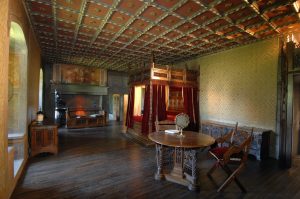
This is a focal point which dominates the road through the Borgo. Solid and robust in appearance, volume-wise, it is similar to the castles of Fénis and Verrès in the Valle d’Aosta, and Montaldo Dora and Ivrea in the Canavese area. It is a fortified stately home, with sumptuous rooms full of furniture, furnishings and textiles, which reflect what life was like in 15th-century castles. The armour, the weapons, the pastimes left in the camerone degli uomini d’arme (men-at-arms’ chamber), the sala da pranzo (dining room), the cucina (kitchen), all offer a truly realistic idea of a 15th-century Savoy castle. After the sala del trono (throne room), where Heroes and Heroines parade, the camera da letto (bedroom) is striking for its large canopy with embroidered curtains; the cappella (chapel) closes the tour.
Move over the map to discover the various rooms
Map of ground floor

Atrio (Entrance hall)

E’ una stanza spoglia con feritoie sul fondo; è difesa da un pesante portone rivestito di ferro e da una grata a saracinesca copiata da un raro originale del castello di Verzuolo.
This is a bare room with slits at the back; it is defended by a heavy iron-clad door and a portcullis grille, the replica of a rare original in castello di Verzuolo.
Cortile (Courtyard)
The inner courtyard, the fulcrum onto which all the rooms open, reproduces that of castello di Fénis in Valle d’Aosta. It has a trapezoidal plan with frescoed walls and galleries accessed by a steep semi-circular staircase.
Camerone degli uomini d’arme
The large room where the castle guards were accommodated was copied from the castello di Verrès. It’s sparsely furnished; the rack of arms and armour is inspired by a decoration in the castello di Issogne, Valle d’Aosta.
Cucina (Kitchen)

It’s divided into two parts: the kitchen for servants and soldiers is also a larder. The kitchen for preparing food for the lords of the manor is dominated by huge fireplaces and furnished with a large quantity of crockery, utensils and cauldrons.
Sala da pranzo (Dining room)

This is the most sumptuous room in the castle – from the ceiling with painted tiles, a replica of one in castello di Strambino, to the carved cupboards full of fine pottery, and the fake tapestry depicting miniatures from a 14th-century manuscript.
Tettoia delle armi (Canopy)

Outside the Rocca (fortress), towards the garden, the canopy copied from the market at Verzuolo, in the Cuneo area, protects two war machines: a catapult and a ballista.
Map of first floor

Stanza del guardiano

This is the control and defence room from where the guard lowered the portcullis to protect the gate in the event of an attack on the castle. The unfurnished room has walls decorated according to an original in the castello della Manta, Saluzzo, which no longer exists.
Antisala baronale

This is the waiting area for those who need to enter the throne room. Carved furniture and walls painted to imitate tapestry are modelled on castello di Issogne in Valle d’Aosta.
Sala baronale

It reproduces the shape and decorations of a hall in castello della Manta, Saluzzo: Heroes and Heroines of Antiquity and the Fountain of Youth, themes dear to courtly and chivalrous literature in the 14th century.
Camera da letto (Bedroom)

The room reproduces the French King’s Room in castello di Issogne. Imposing in the centre of the room is the four-poster bed with thick velvet curtains.
Oratorio (Oratory)

Small in size, it is a place of meditation and prayer, furnished with silk curtains on the walls and a small altar with a kneeling-stool.
Stanza della damigella (Chambermaid’s room)

This is the chambermaid’s room, small and modest but well-furnished or decorated. On the walls, the initials of King Arduin of Ivrea are painted in diamond shapes.
Cappella (Chapel)

The chapel is crossed by railings separating the servants from the lords of the manor. There are many references in this room; its walls depict the famous Ascent of Christ to Calvary, painted by Giacomo Jaquerio in the Monastery of Sant’Antonio di Ranverso, around 1420.
Visit the Rocca with Google Arts & Culture
